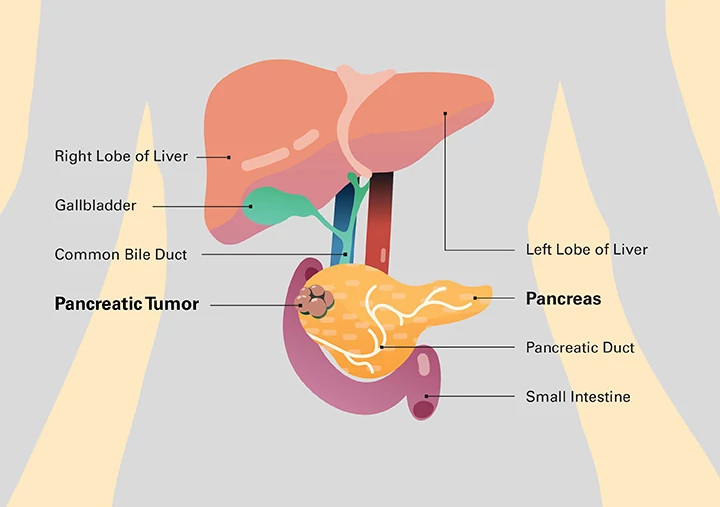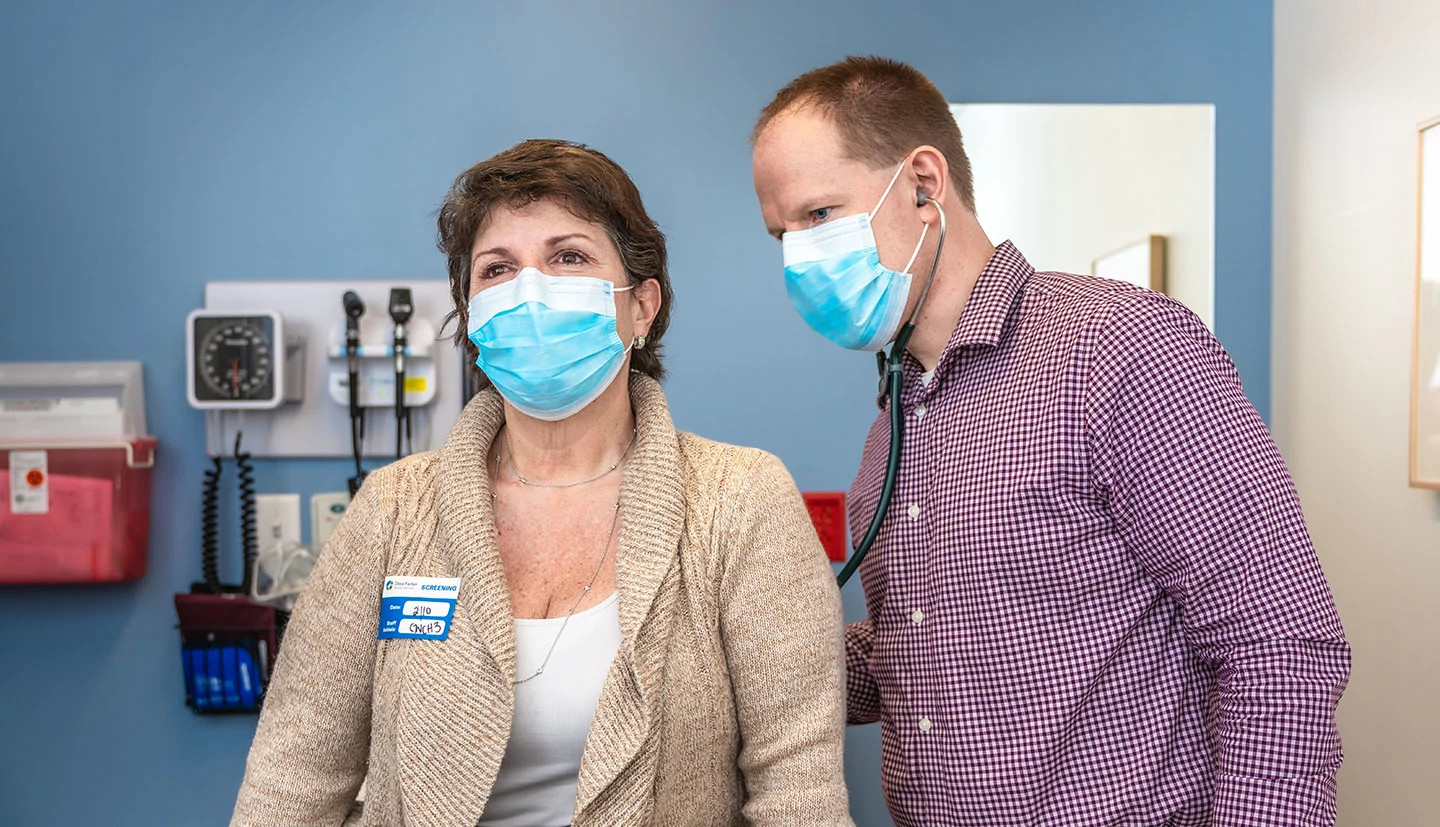
How Dana-Farber Is Transforming the Narrative in the Early Detection and Treatment of a Stubborn Cancer
March 16, 2023
BRCA
Lynch Syndrome
Research
Pancreatic Cancer
By Kara Baskin
Pancreatic cancer is notoriously difficult to treat. It's commonly discovered at an advanced stage with distant metastases. But innovations in genetic testing and early detection at Dana-Farber are transforming this narrative — giving patients renewed hope for successful long-term treatment and even cures.
Pancreatic cancer is relatively uncommon: For the average adult, the lifetime risk is a little more than 1%. However, it's also deadly. The five-year survival rate hovers at about 10%. It's a complicated cancer to diagnose because of its location and its non-specific warning signs, such as indigestion or fatigue.


"The pancreas is deep in the abdomen, so it's not generally something a physician can feel when they examine a patient," explains Brian Wolpin, MD, MPH, director of Dana-Farber's Gastrointestinal Cancer Center and the Hale Family Center for Pancreatic Cancer Research. "It's only when it gets bigger and spreads that it more commonly causes symptoms."
In the U.S., roughly 85% of pancreatic cancers occur sporadically, meaning without a known genetic or familial cause. Meanwhile, approximately 15% of pancreatic cancer patients have a family history of the disease or a genetic mutation that causes it.
"Over the course of our research, we found that about 10% of people with a new diagnosis of pancreatic cancer actually had a genetic mutation that may have been related to development of that cancer, which was a higher percentage than we had previously realized," Wolpin says.
Common gene mutations related to inherited pancreatic cancer include BRCA1 and BRCA2 (which also increase breast, ovarian, and prostate cancer risk); CDKN2A; ATM; and PALB2. Some patients have a cancer-causing genetic syndrome called Lynch syndrome, or hereditary pancreatitis. In addition to those with a genetic predisposition, some individuals with intraductal papillary neoplasms, high-risk cysts that often appear as incidental findings on a routine CAT scan may develop pancreatic cancer.
The Promise of Genetic Testing
Recently, the role of inherited mutations in pancreatic cancer has become more widely understood — and more urgently leveraged toward a cure.

The National Comprehensive Cancer Network (NCCN) recommends that every pancreatic cancer patient undergo a genetic blood test, says Sapna Syngal, MD, MPH, director of research at the Center for Cancer Genetics and Prevention. But, because pancreatic cancer is so lethal, some patients may pass away before testing has been performed. That's why it's so important to get tested if a first-degree relative has died of the disease.
"If you have a family history of pancreatic cancer, people should also talk to their doctor about genetic testing to see if they're at an increased risk," Syngal says. "It's a proactive approach, the same way that you would talk about getting a mammogram."
Genetic testing confers more than knowledge: It can also unlock a potential cure. In 2022, research detailing 20 years of follow up from the Cancer of the Pancreas Screening (CAPS) consortium was published in the Journal of Clinical Oncology. It showed that screen-detected pancreatic cancers are diagnosed at much earlier stages, with encouraging long-term survival rates.

"We found that early detection is possible," says Matthew B. Yurgelun, MD, director of the Lynch Syndrome Center at Dana-Farber. "But more important, we found that early detection leads to a much higher chance of cure." This is especially exciting because pancreatic cancer was often thought to have a bleak prognosis regardless of stage at detection.
"The long-term survival — what appears to be the cure rate — was higher than 70% in these people, who had pancreatic cancer found through aggressive screening," Yurgelun says. "Early detection is possible, and early detection leads to better outcomes."
Making Advance Screening Possible for More People
Genetic testing and surveillance aren't always easy: Cost, location, and anxiety can be crippling factors. As such, Dana-Farber led the landmark GENERATE (GENetic Education, Risk Assessment, and TEsting) study for people who have a first-degree relative with pancreatic cancer that may have been caused by an inherited gene mutation. The study aimed to determine if giving people genetic information in different ways, such as remotely rather than traveling to a hospital, would affect their decision to undergo testing.
"This was an approach to make genetic testing easier for family members who've been affected by pancreatic cancer, because there are a lot of barriers to getting people tested: They don't have doctors who are offering testing in their communities, or they can't get to a cancer center," Syngal says. "We did all testing remotely, with all the genetic education done from the patient's home."
The study was a huge success: 90% of participants from across the U.S. went on to complete genetic testing. The study spurred a follow-up, REGENERATE (Racial and Ethnic Equity and Risk Assessment), aimed at Black and Latinx populations. Syngal and Nicolette Rodriguez, MD, MPH, of Dana-Farber Brigham Cancer Center, are the lead investigators on this ongoing study, working with community leaders to understand barriers to testing among underrepresented groups.
"I think the awareness around families and risk is only just beginning," Wolpin says. "We have one of the largest genetics clinics related to pancreatic cancer in the country, and we really want people to be seen in clinic who have a family history of pancreatic cancer."
For patients like Cheryl Leahy, the results can be life-changing — and life-giving. Leahy's mother was diagnosed with stage IV ovarian cancer in her early 60s and was diagnosed with advanced pancreatic cancer 18 years later. An aunt also had breast cancer, and her grandmother had ovarian cancer.
For years, Leahy was known as a "pre-vivor" — someone at increased risk for cancer due to family history. Leahy tested positive for the BRCA gene and was seen by Judy Garber, MD, chief of the Center for Cancer Genetics and Prevention.
"I have two daughters, [so] I said, 'Put me in whatever study, put me in whatever test, put me in anything," explains Leahy, who underwent annual MRIs and mammograms, ultimately opting for a preventative bilateral mastectomy. "I felt like that cancer train was coming right at me, and I wanted to do everything to try to head it off."
In 2011, after her mother died of pancreatic cancer, Leahy began monitoring for pancreatic cancer, too, through MRIs and endoscopic ultrasound. In February 2022, after a decade of careful monitoring, doctors at Dana-Farber diagnosed her with Stage IIB pancreatic cancer after an endoscopic ultrasound. She was 59. Her mother had been 78.
"Driving down Route 95, I was in tears; I wasn't even 60 yet," Leahy said. "But I didn't need to make a single phone call. Everything was handled for me. The Dana-Farber troops all knew what they needed to do, and I just moved forward with what they told me needed to be done."
Thomas Clancy, MD, co-director of the Pancreas and Biliary Tumor Center at Dana-Farber Brigham Cancer Center, removed two-thirds of her pancreas and 36 lymph nodes, only one of which was malignant. In October 2022, she finished 12 rounds of chemotherapy with Yurgelun.
Now, she walks every morning, wearing gloves to keep neuropathy at bay. She also takes insulin. For the next two years, Leahy will return to Dana-Farber every three months for bloodwork and CAT scans. Then, she'll resume annual monitoring through endoscopy and MRI. Her regimen is especially effective in patients with the BRCA2 mutation — which, happily, her daughters did not inherit.

Monitoring Those at High Risk for Pancreatic Cancer
Identification of patients like Leahy is just the beginning. Currently, higher-risk patients are monitored via endoscopic ultrasound and MRI, typically beginning either at age 50 or 10 years before the age of a family member's diagnosis.
Right now, there are no current recommendations for screening in the general population because, while pancreatic cancer is lethal, it's also uncommon — whereas cancers with surveillance protocols, such as breast or colon, are more prevalent. But Dana-Farber physicians say that less invasive procedures are on the horizon, such as machine learning algorithms that could identify at-risk patients even if they don't have genetic or familial risk.
Wolpin is studying predictive machine learning approaches, together with research collaborators at Dana-Farber, including Michael Rosenthal, MD, PhD, and Chris Sander, PhD, to analyze electronic medical records for clues. The goal of this work is an algorithm that would be able to identify a combination of features, such as rising glucose, weight loss, changes in heart rate that, in aggregate, could provide a more precise pancreatic cancer risk estimate.
In turn, flagged patients could be screened similarly to hereditary risk patients, with annual MRIs, endoscopic ultrasound, or maybe even blood tests.
"I hope that we'll be able to further refine people's risks not just based on how many family members they have, but by some of these characteristics we learn in the larger population," Wolpin says. "We then can tailor how often we need to do a blood test or how often someone should get an MRI."
The Potential for a Pancreatic Cancer Vaccine
Wolpin is also hopeful that patients could be vaccinated against the DNA gene mutations that occur in pancreatic cancer patients. Data for this could be available in five to 10 years.
"There's really a large amount of work going on for vaccines to get the immune system to attack the cancer right away, right when it starts, and get rid of it before it even would show up on our scans," Wolpin says. "Ultimately, this type of interception approach could hold great promise for curing patients of their pancreatic cancer."
In the meantime, the reality for pancreatic cancer patients and their families looks more promising than ever before.
"We'd made very little progress in pancreatic cancer medicine up until recently, but the amount of progress that we've seen in a short period of time is staggering in my mind, [both] as far as treating pancreatic cancers but [also] understanding who has risk and doing something about that risk," Yurgelun says. "I'm seeing people who are living, surviving, doing all the things that you'd want to do after a pancreatic cancer diagnosis. There is now life after pancreatic cancer."
Cheryl Leahy can attest to that.
"People say, 'You're living with cancer?,'" Leahy explains. "I say, 'I don't have cancer; they took it out.' I'm very open about it. I'm a success story and absolutely feel like I'm blessed that it was caught early because I worked with Dana-Farber and made sure that I stayed on my schedule."